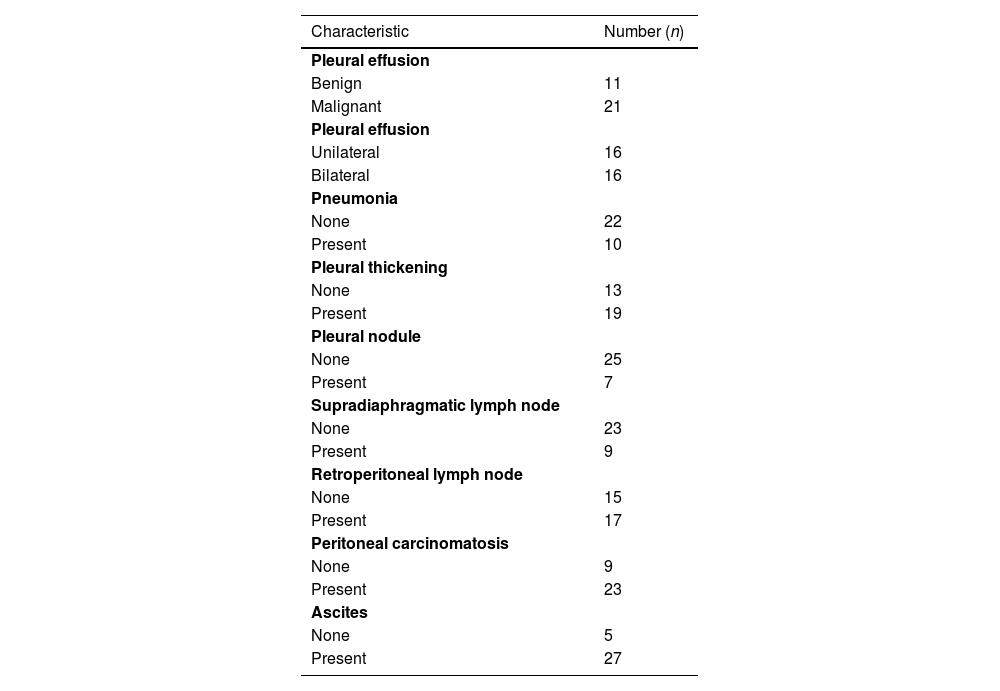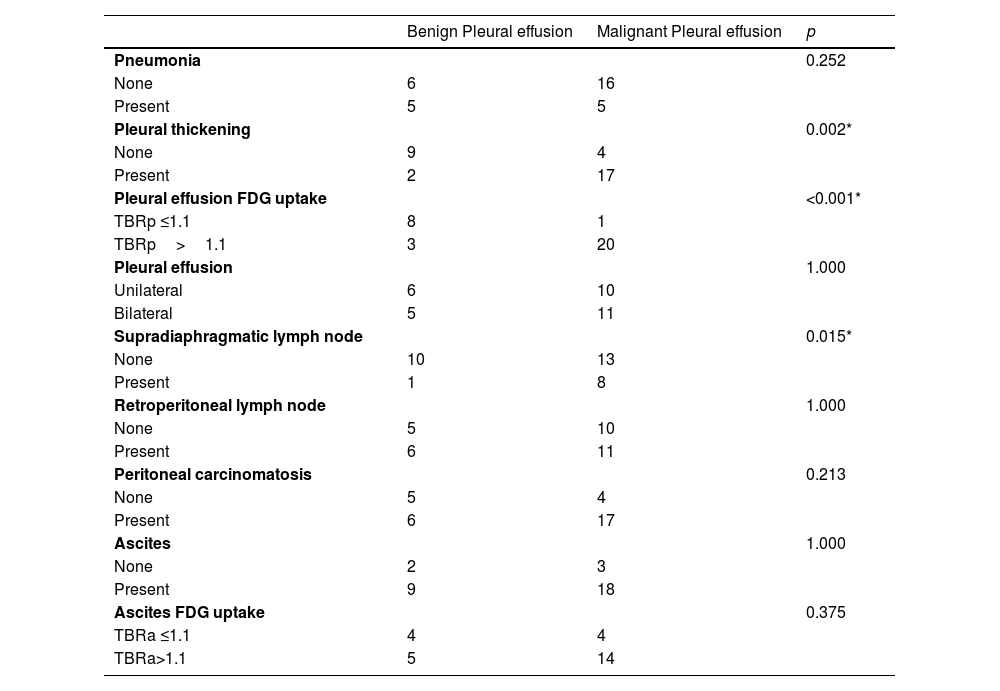The present study investigates the ability of non-invasive contribution of positron emission tomography (PET)/computed tomography (CT) to distinguish between benign pleural effusions (BPE) and malignant pleural effusions (MPE) in patients diagnosed with ovarian carcinoma (OC).
Material and methodsIncluded in the study were 32 OC patients with a PE diagnosis. The cases with BPE and MPE were compared in terms of the PE maximum standardized uptake value (SUVmax), PE SUVmax/mean standardized uptake (SUVmean) value of the mediastinal blood pool (TBRp), the presence of pleural thickening, the presence of supradiaphragmatic lymph node, unilateral or bilateral PE, pleural effusion diameter, patient age and CA125 value.
ResultsThe mean age of the 32 patients was 57±2.8 years. TBRp>1.1, pleural thickening and supradiaphragmatic lymph node were observed significantly more frequently in the MPE than the BPE cases. While no pleural nodules were detected in patients with BPE, they were present in 7 of the patients with MPE. The rates of distinction between the MPE and BPE cases were as follows: the sensitivity of the TBRp value was 95.2% and specificity was 72.7%; the sensitivity of pleural thickness was 80.9% and specificity was 81.8%; the sensitivity of supradiaphragmatic lymph node was 38% and specificity was 90.9%; and the sensitivity of the pleural nodule was 33.3% and specificity was 100%. There were no significant differences between two groups in any other factors.
ConclusionsPleural thickening and TBRp values ascertained through PET/CT may aid the distinction between MPE-BPE, especially in patients with advanced stage OC with a poor general condition, or those who cannot undergo surgery.
El presente estudio investiga la capacidad de los hallazgos de la tomografía por emisión de positrones (PET)/tomografía computarizada (TC) en la diferenciación no invasiva de derrame pleural benigno (DBP) y derrame pleural maligno (DMP) en pacientes diagnosticadas con carcinoma de ovario (CO).
Material y métodoSe incluyeron en el estudio 32 pacientes con DP diagnosticados con CO. Los casos con DBP y DMP se compararon en términos de; valor máximo de captación estandarizado (SUVmax) de DP, valor medio de captación estandarizada (SUVmean) del valor de captación estandarizado (TBRp) de PE SUVmax/ pool de sangre mediastínica, presencia de engrosamiento pleural, presencia de ganglio linfático supra diafragmático, DP unilateral o bilateral, diámetro del derrame pleural, edad del paciente y valores de CA 125.
ResultadosLa edad media de las 32 pacientes fue de 57±2,8 años. TBRp>1.1, engrosamiento pleural y ganglios linfáticos supra diafragmáticos fueron significativamente más comunes en DMP que en DBP. Si bien no se detectó ningún nódulo pleural en pacientes con DBP, 7 pacientes con DMP tenían nódulos pleurales. Los índices de distinción entre los casos DMP y DBP fueron los siguientes: sensibilidad del valor de TBRp fue del 95,2 % y la especificidad del 72,7 %, la sensibilidad del 80,9 % y la especificidad del 81,8 % para el engrosamiento pleural, la sensibilidad del 38 % y la especificidad del 90,9 % para los ganglios linfáticos supra diafragmáticos, la sensibilidad del 33,3 % y la especificidad del 100 % para los nódulos pleurales. No hubo diferencia significativa entre los dos grupos en términos de otros factores.
ConclusiónEl engrosamiento pleural y el valor de TBRp observados en la PET/TC pueden contribuir a la diferenciación de DMP-DBP, especialmente en pacientes con CO en estadio avanzado con mal estado general o que no pueden someterse a un procedimiento quirúrgico.
Artículo

Revista Española de Medicina Nuclear e Imagen Molecular (English Edition)
Comprando el artículo el PDF del mismo podrá ser descargado
Precio 19,34 €
Comprar ahora











